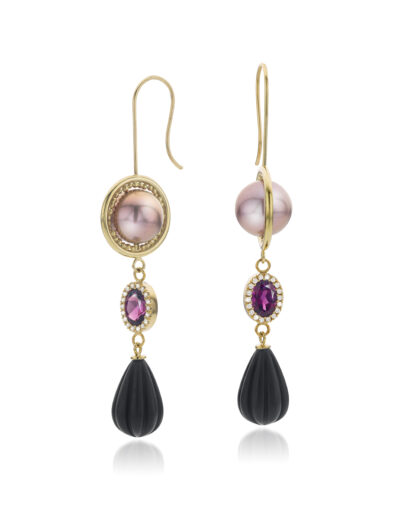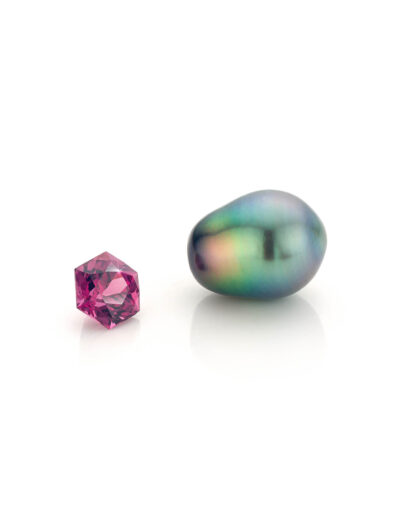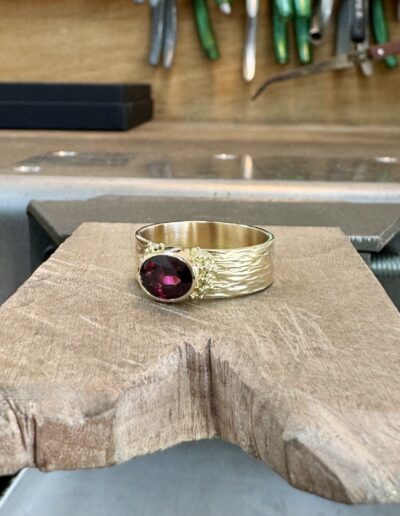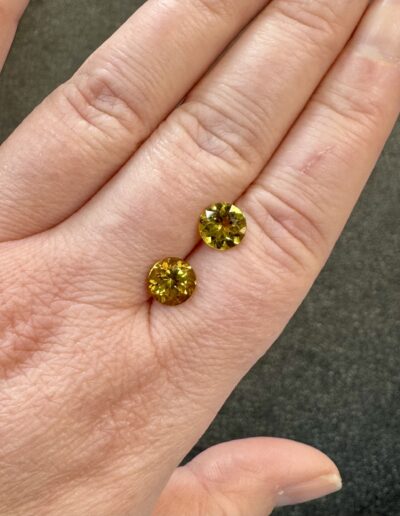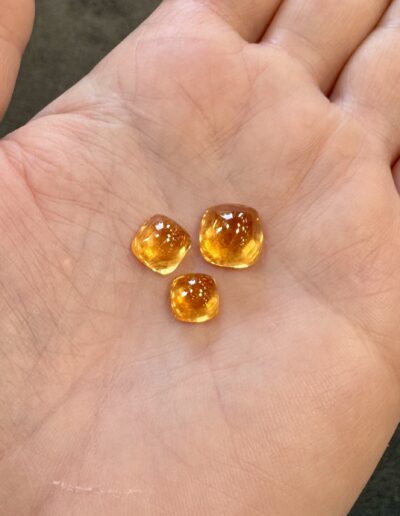During my last shopping day at BirGem in Schoonhoven, I fell in love with a beautiful yellow garnet: a Mali garnet. As you may know, I have a massive fondness for tourmaline.
And while I was checking out various gemstones at BirGem that day (and so was a batch of tourmalines), I told one of the employees that I was going to take “that yellow tourmaline” with me as well. To which he replied very carefully, “Um, Sarah … that’s a garnet.”
To my happy surprise, my former lecturer, Drs. George Hamel, FGA, was also present at the time. I asked him if he could explain to me a little more about this group of gemstones – and boy oh boy, that turned into a crash course in garnet!
And yes, I admit it: I have some blinders on. Tourmaline is and always has been my “weakness. However, the beautiful story and Mr Hamel’s infectious enthusiasm still shone in a new light.
(And despite the fine relationship I have with Bir and the team at BirGem, it remains odd to call Mr Hamel “Sjors. Due to his prestige and vast knowledge, it simply doesn’t feel appropriate. After all, he was my gemology teacher at the Schoonhoven Trade School and is quite a household name in our industry.
Anyway, so I went home with some beautiful tourmalines (but of course), as well as some gorgeous gemstones from the garnet group. And at home, it occurred to me: I should write something about this.
Because the garnet gemstone is SO much more than that classic necklace. You probably know it, one of those multi-row necklaces you may have inherited from your mother or grandmother.
The garnet group: one family, many colours
The garnet belongs to a group of different types of coloured gemstones that share a similar crystal structure and chemical composition. Within that group, there are six main species, each with its own colour, composition and character.
That kinship yields an impressive variety of hues, ranging from fiery red to bright green, and from soft orange to a purple-pink.
The name “garnet” comes from the Latin granatus, which means “grain” or “seed” (which, by the way, I think fits my granules very well again!). This refers to the round crystal shapes in which these gemstones are often found.
Many people immediately think of garnet as a dark red gemstone, like the classic necklaces and rings of yesteryear. But that is only one face of this multifaceted family.
The six main types are:
Pyrope – the classic red garnet often seen in antique jewellery.
Almandine – slightly darker in tone, with a deeper red or purplish-red character.
Spessartien – warm orange to orange-brown; also called tangerine garnet.
Grossular – ranges from colourless to green; the intense emerald green tsavorite is the best known variety of these.
Andradite is green primarily or yellow-green; demantoite is the rarest and most sparkling variety, characterised by a diamond-like brilliance.
Uvarovite – rare and bright green, often too small to grind, but beautiful as a natural cluster.
Many garnets are mixtures of two main types. Well-known examples are rhodolite (a mixture of pyrope and almandine, with a purplish-pink to red colour), Malaya garnet (between pyrope and spessartine, often orange-pink) and Mali garnet (between grossulite and andradite, usually yellow-green in colour).
Confusion often arises between the two green garnets: tsavorite and demantoite. They are similar in colour but differ in composition. Tsavorite is a green variant of grossular, while demantoite is a green variant of andradite.
Demantoite is slightly softer, but shines more strongly. It has a higher index of refraction (When light enters a gemstone, it changes direction. How strongly that happens is called the refractive index. The higher the refractive index, the more brilliance a stone shows) and more dispersion, which creates that sparkling “diamond-like” effect. Tsavorite is slightly harder and therefore more suitable for daily wear.
The charm of purple garnet
One of my personal favourites within this family is the purple garnet – a mixture of pyrope and almandine found in Mozambique.
What makes this variant special is that the colour is not just red or pink, but a deep, velvety purple shade with a subtle glow. In ordinary daylight, she sometimes appears wine-red, but under artificial light, a glimmer of purple-blue appears.
According to the GIA, this specific hue occurs because, in the mineral, small amounts of elements such as magnesium and iron combine uniquely. Simply put, nature creates its own colour palette, and the most minor differences in composition create completely different nuances.
For those who love gemstones with character, the purple garnet has a mysterious and elegant quality all at once. She radiates warmth but looks sophisticated. This makes her perfect for jewellery that allows for just that little bit of depth and layering. And she is very different from the colour purple we know from amethyst.
My favorites from the garnet family
In my studio, I work mainly with rhodolite and tsavorite, and I also have a Malaya garnet and a yellow Mali garnet in my collection.
Rhodolite has a special, purple-pink glow that combines beautifully with gold. Tsavorite, on the other hand, is a vibrant green with incredible clarity. And the Mali garnet – the “surprise of the day” at BirGem – proved to be a real eye-catcher with its warm, golden sheen.
Garnet has become, for me, since that day at BirGem, a gemstone with character as well as versatility. A gemstone that shows how rich nature is in colour and form.
And fair is fair: thanks to that one yellow garnet, I now look at this ancient, yet alive and kicking gem group with very different eyes. As you can see, I’ve been in this business since 2000, but I continue to learn. And that is the best thing about this craft.
Did you know…
…The quality of the garnet is mainly determined by colour and clarity. The finest garnets have a vibrant hue – neither too dark nor too light.
With green varieties, such as tsavorite and demantoite, this plays an additional role: the fresher the green, the more the gemstone comes alive.
Demantoite also often has so-called horse-tail inclusions: fine, fibrous lines that run fan-like from the heart of the stone. Remarkably, these inclusions do not lower the value, but rather raise it. They are characteristic of high-quality natural demantoite and are seen as a sign of authenticity as well as beauty.
The cut also makes a difference. Dark garnets are often cut a little shallower to make the colour appear lighter. Lighter ones, on the other hand, are ground slightly deeper for added intensity. And with larger specimens – above five carats – the rarity as well as the value increases rapidly, especially with tsavorite, demantoite and rhodolite.
In conclusion
Are you curious about the jewellery in which I work with garnet – from the warm glow of rhodolite to the sparkling green of tsavorite or the sunny yellow of Mali garnet? Feel free to contact me or see more about the gemstones I work with on the gems and pearls page.



